Slate Pit Hill
Hill, Mountain in Yorkshire
England
Slate Pit Hill

Slate Pit Hill is a prominent hill located in the county of Yorkshire, England. Situated in the heart of the Yorkshire Dales National Park, it stands at an elevation of approximately 450 meters (1476 feet) above sea level. This natural beauty is a popular destination for hikers, nature enthusiasts, and outdoor adventurers.
The hill gets its name from the abundance of slate rocks that can be found on its slopes. These slate deposits have been used for centuries in the local area for building materials, roofing, and even as writing tablets in the past. Today, remnants of the old slate mining industry can still be seen around the hill, adding to its historical charm.
From the summit of Slate Pit Hill, visitors are treated to breathtaking panoramic views of the surrounding Yorkshire Dales landscape. Rolling hills, picturesque valleys, and meandering rivers create a stunning backdrop that captures the essence of rural England. On clear days, it is even possible to catch a glimpse of the iconic Three Peaks, which are located a short distance away.
The hill is accessible via several footpaths that wind through the Dales, allowing visitors to explore its natural wonders at their own pace. Along the way, they may encounter an array of wildlife, including birds of prey, sheep, and wildflowers that add color to the landscape.
Slate Pit Hill is a true gem in the Yorkshire Dales, offering visitors a chance to immerse themselves in the beauty of the countryside and connect with nature. Whether it's a leisurely stroll or a challenging hike, this hill provides an unforgettable experience for all.
If you have any feedback on the listing, please let us know in the comments section below.
Slate Pit Hill Images
Images are sourced within 2km of 53.65928/-2.0231443 or Grid Reference SD9818. Thanks to Geograph Open Source API. All images are credited.




Slate Pit Hill is located at Grid Ref: SD9818 (Lat: 53.65928, Lng: -2.0231443)
Division: West Riding
Unitary Authority: Calderdale
Police Authority: West Yorkshire
What 3 Words
///buckling.wealth.puns. Near Littleborough, Manchester
Related Wikis
Blackstone Edge Reservoir
Blackstone Edge Reservoir is a reservoir in the Metropolitan Borough of Rochdale, Greater Manchester, England. It is close to Blackstone Edge, from which...
Baitings Reservoir
Baitings Reservoir is a large water supply reservoir operated by Yorkshire Water close to Ripponden in the West Yorkshire Pennines, England. It lies in...
Blackstone Edge
Blackstone Edge ( BLAK-stən) is a gritstone escarpment at 472 metres (1,549 ft) above sea level in the Pennine hills surrounded by moorland on the boundary...
Ryburn Reservoir
Ryburn Reservoir is a supply reservoir operated by Yorkshire Water close to Ripponden in the Yorkshire Pennines, England. It lies in the valley of the...
Nearby Amenities
Located within 500m of 53.65928,-2.0231443Have you been to Slate Pit Hill?
Leave your review of Slate Pit Hill below (or comments, questions and feedback).
















